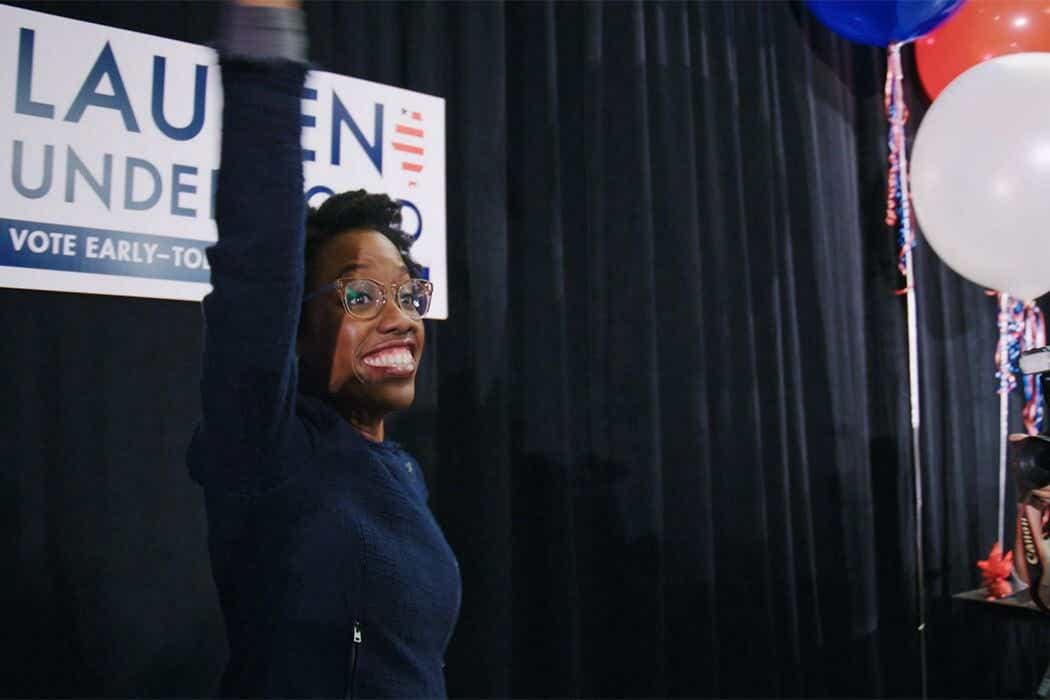Nearly 600 women ran for the House, Senate or governor in 2018 — an unprecedented swell of female candidates. Observers called it a “Pink Wave,” a backlash to Hillary Clinton’s stunning defeat in 2016 and an extension of the historic Women’s March.
“I see women waking up, like I’ve never seen them awakened before,” a director of the Campaign School at Yale says in the new film.
Many of the women were progressive, first-time candidates who describe a similar path to the ballot. They were ordinary voters, who had “never imagined” a political career but felt moved after the election to seize a seat at the table, says Wendy Sachs, who with Hannah Rosenzweig, directed and produced the film.
“Surge” follows three such candidates, Jana Lynne Sanchez, Liz Watson and Lauren Underwood — who became the youngest Black woman ever elected to the House — in their campaigns to unseat the incumbents in their districts.
Wake-Up Call: What drove you two to tell this story?
Sachs: After the 2016 election and after the women’s march, we started seeing stories everywhere of all these women throwing their hats into the ring and saying that they were running for office. These are women who largely had never run for office before.
We were so taken by what was happening, by the surge of female candidates, who were running for the very first time. Women who had never imagined that they would be running for office at all, or certainly not at this moment, and they felt like they needed to do something — more than marching, more than writing postcards, more than calling their members of Congress. They actually had to run for office, and they had to take a seat at the table. This is really what inspired the film.
“Surge” focuses on three women in very different districts — all first-time candidates looking to flip GOP-held seats. Can you talk about what went into choosing your subjects?
Rosenzweig: We decided early on that our story was about first-time candidates because that’s what we were seeing — that there was a surge of women after the women’s march that were saying we’re not just gonna march we have to do something. That was so interesting and amazing, that energy that we were seeing in 2017.
We also decided to look at women running to flip their districts. Women who saw in their own communities looked at who was representing them and felt like this person doesn’t represent me. This is not who I want my leader to be. This person doesn’t believe in what I believe or have the values that I have, and it’s up to me to do something about that.
There were a few other films out there at the time, already in motion about women running. And a lot of times they were focused on more Democratic districts and we felt it was super important to highlight the tough races. These women saying, “OK, even though Trump won our district by — in Liz Watson’s case 26 points — Liz still said, ‘hey I’m jumping in. I’m gonna do this.’”
Sachs: We also wanted to make sure we captured a real diversity of women running — geographically, racially, age-wise and where they were in their lives. Liz is a mother, in her mid-forties with two young children. Janna is about 50 years old, divorced, no children. And Lauren’s a young, Black millennial. So we really wanted to capture different types of characters that represented different parts of the country.
One question you tackle in the film is if the 2018 cycle was a blip or the beginning of lasting change. Can you speak on that?
Sachs: That was such an important question that we asked throughout the film — is this a moment or is it a movement? The film opens with a quick look at women’s political history and we also look at 1992, which was coined the “Year of the Woman,’ because more women were running for Congress than ever before. Then it just petered off, it was a one-cycle surge of women running. We kept hearing in the 2018 midterms, oh it’s another “Year of the Woman.” So we kept asking that question to everyone, is it a blip or is it a true trend?
All the political people we’ve asked, definitely believe it is a movement. We see it continuing into 2020. More women are running in 2020 than ran in 2018 and the numbers are really stunning on both sides of the aisle. We’re still not close to gender parity in Congress, but there’s something happening.
What do you hope viewers take away from “Surge?”
Rosenzweig: It’s so important for this moment that viewers leave feeling that they can get engaged, because they saw these three women who were just normal women, like all of us, that decided that they had to take action to do something in their communities and they did and we see how they did it and we see that it’s possible for all of us to do the same in whatever way we want to be involved.
Sachs: We want people to feel really activated and engaged, to feel that their vote counts, that their involvement makes a difference, and that who you elect as leaders matters. And that you can make that happen. You can feel empowered to make sure that your work counts. We want to inspire girls, we want to inspire women to see themselves as leaders.
We loved seeing in 2018 that women, to quote one of our experts, were waking up like she’s never seen them awoken before. We want to keep that energy and enthusiasm alive.
This interview has been edited and condensed.
This originally appeared on Medium.









